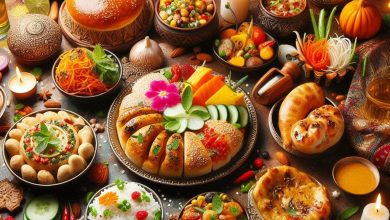Indian cuisine Why do Russians need biryani, vindaloo and tikka masala?

However, Indian cuisine – spicy, hot, aromatic, with a lot of sauce – is perfect for the chilly Russian autumn. Maybe it’s not for nothing that they are so loved in Britain, where it rains all the time? One way or another, chicken tikka masala, palak paneer, vindaloo shrimp and other dishes with outlandish names can greatly brighten up the cold season. The main thing is to learn how to cook them or find a place where professionals do it.
Why Russia loves Indian cuisine
Indian cuisine came to Moscow around 2016, simultaneously with the massive opening of food courts in old markets and shopping centers. Perhaps it has not gained the same wild popularity as Georgian or Vietnamese, but there are always loyal fans in the corners of the Danilovsky and Central markets, as well as in the Depot. What are they looking for?
A significant part of Indian cuisine is vegetarian. There is an explanation for this. Firstly, the cow in India is a sacred animal, therefore, eating beef is prohibited. In some Muslim states, pork is also prohibited. All that remains is chicken or lamb. Secondly, meat is poorly preserved in hot weather. Therefore, a significant part of the recipes involve the use of vegetables, homemade paneer cheese, and chickpea meatballs. Another reason: simple poverty—few people can afford to eat meat every day.
The main stereotype: all Indian dishes are very spicy. This is only partly true: indeed, spices are used to preserve food in the hot climate of India. However, there are many recipes for sauces without adding hot pepper that will appeal to almost all Europeans. In addition, in most Indian restaurants, the cook or waiter will definitely specify the degree of desired spiciness: you can order both fiery and very mild curry.

Much of Indian cuisine depends on the state. The largest number of meat dishes can be found in the diet of residents of the northern states (for example, Kashmir), but in the south the food will be predominantly vegetarian. In Goa, coconut milk is often added to dishes. In those states where Islam or Christianity is not Hinduism, you can find beef dishes. But still this is rare. Fish and seafood are most often prepared in the southwest of the country.
It is important to understand: the Indian cuisine that we can enjoy today in cafes and restaurants has passed through a strict filter in Britain. Some dishes are even debated: were they truly invented by Indians or inspired by trips to India by European chefs? Just as a significant part of the rolls and sushi in our restaurants has nothing in common with real Japanese cuisine, chicken curry prepared by Europeans may bear little resemblance to a dish from India.
What is cooked in India
Indian cuisine recipes can be divided into several conventional groups (cooking styles), within which cooks are limited only by their imagination.
Tandoori dishes. In the post-Soviet space, we know this word – tandoor, that is, a special oven. Lamb or fish are also cooked in the oven: for example, tandoori sea bass.
Shrimp can also be baked in a yogurt marinade. Tandoori dishes are served akin to shish kebab: with a vegetable side dish, flatbread and a generous slice of lemon to drizzle over the meat. You can also add a yogurt-based sauce.
Gave. Despite the hot climate, people in India treat soups with respect and often serve them on the table. Dal is most correctly called a thick stew: this dish can be eaten as a stew, or it can be prepared more liquid and served as a soup. The composition necessarily includes red lentils, other ingredients vary – it can be eggplant, cauliflower, carrots.

Biryani. A traditional rice dish with additives that will appeal to connoisseurs of pilaf and risotto. There is no sauce here, the rice should be crumbly. Chicken, shrimp, eggs and even dried fruits can be used as additives.
Sabji. This is a national vegetable stew with cauliflower, peas, carrots and other vegetables, seasoned with local spices. Sometimes lentils, chickpeas or mung beans are added.
Russian housewives can safely adopt this recipe: if the usual stew seems too boring, you can just add seasonings like garam masala and everything will sparkle with new colors. Another name for vegetable stew is alu gobi: in this version, potatoes must be added.
Curry. Russians, inexperienced in gastronomy, are accustomed to calling the bright reddish-brown seasoning from a bag the word “curry.” This is not entirely a mistake, but still the very concept of curry in Indian cuisine is much broader – this word refers to a huge number of dishes made from chicken, lamb, cheese or vegetables cooked in a thick, spicy sauce. Curry is a cooking technique, but also a mixture of spices that provides heat and flavor.
Chicken tikka masala. Pieces of chicken, pre-marinated and baked in tandoori, and then stewed in a spicy sauce with the addition of tomato, butter, spices and fresh cilantro. This dish has already become a symbol of Indian and, at the same time, British cuisine: it’s all due to the colonial past – remember that India was called the pearl of the British Empire. There is debate about the origin of this dish: some believe that cooking chicken in masala sauce began not in India at all, but in one of the first Indian restaurants in London’s Soho in the mid-twentieth century.
